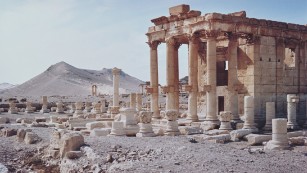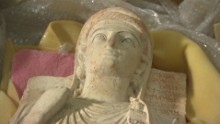ISIS reported to have blown up ancient temple in Palmyra
The burgeoning list of appalling acts by ISIS has grown even longer: The Islamic extremist group has blown up a nearly 2,000-year-old temple in the historic ruins of Palmyra, Syria.
Maamoun Abdulkarim, Syria's director-general of antiquities and museums, said Sunday that sources in Palmyra informed him that ISIS members rigged the Temple of Baalshamin with large quantities of explosives and detonated them.
There was uncertainty -- not unusual amid the chaos of the Syrian conflict -- over when exactly the damage was done to the temple, which dates from the first century.


A Syrian Arab News Agency report Sunday didn't specify when the explosion took place. The UK-based Syrian Observatory for Human Rights, which monitors the conflict, reported on the same day that its sources said ISIS blew up the temple about a month ago. But Abdulkarim said it was blown up Sunday.
'They lied'
The Syrian government's Directorate-General of Antiquities and Museums is trying to find out more from people in Palmyra about the extent of the damage.
"They destroyed an incredibly important architectural structure," Abdulkarim said. "It is the first structure in the Palmyra complex to be destroyed, although they recently destroyed two Islamic shrines nearby.
"They said they would destroy the statues but not the structures themselves insidePalmyra. They lied."
He called it a loss for all Syrians and for the international community.
The reports come less than a week after the observatory said ISIS militants hadpublicly beheaded Khaled al-As'ad, 82, the former general manager for antiquities and museums in Palmyra.
ISIS fighters seized control of Palmyra and the nearby modern town of Tadmur in May, prompting fears over what the militants would do to the UNESCO World Heritage Site.
Track record of trashing heritage sites
On top of its atrocities of rape, enslavement and killing, ISIS has also blown up other historical sites and destroyed or sold antiquities in the parts of Syria and Iraq that it controls. The group says it considers religious shrines idolatrous.
Dedicated to the Phoenician god of rain and fertility, the Temple of Baalshamin was a small shrine, the only part of a larger compound that survived the centuries somewhat intact, according to the Lonely Planet travel guide.
The Directorate-General of Antiquities and Museums had previously said that ISIS had destroyed two ancient Muslim shrines, one in Palmyra and another a few kilometers away.
Other monuments, temples and historic buildings have been mined, and a statue of a lion at the entrance to Palmyra's museum has been destroyed.
Elsewhere, ISIS has released footage of its fighters smashing artifacts in the museum of the Iraqi city of Mosul and using sledgehammers, power tools and explosives to destroy the ancient Assyrian city of Nimrud.
News Courtesy: www.cnn.com











